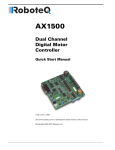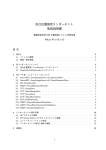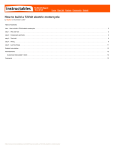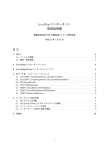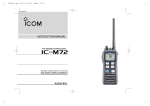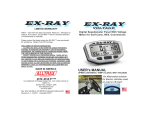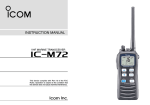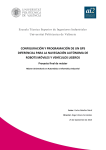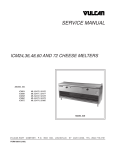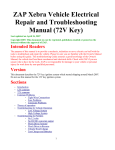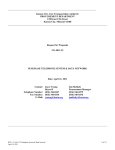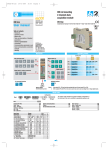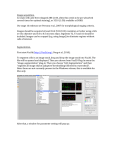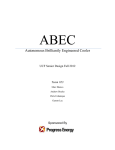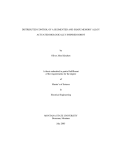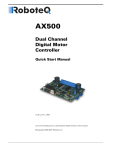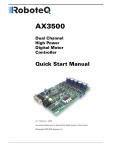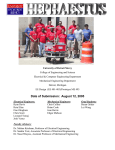Download Here - Cal Poly San Luis Obispo
Transcript
Autonomous Golf Cart Navigation Using ROS∗ David Allender Justin Kuehn Computer Engineering Cal Poly, San Luis Obispo Computer Engineering Cal Poly, San Luis Obispo [email protected] [email protected] Adam Miller Brett Wellman Jason Young Computer Engieering Cal Poly, San Luis Obispo Computer Engineering Cal Poly, San Luis Obispo Computer Engieering Cal Poly, San Luis Obispo [email protected] [email protected] [email protected] ABSTRACT This paper describes how the usage of the Robotic Operating System facilitates the creation of an autonomous vehicle from a standard golf cart. Robotic Operating System’s large and powerful feature set allows for easy organization and communication between the many different system-critical components necessary to create an autonomous golf cart. In this document, the background, rational, and node (or module) information of the Robot Operating System implementation will be explained in detail. The testing methodologies used in completing the autonomous golf cart transformation will be explained as well. Keywords autonomous navigation, ROS, golf cart, robot, remote control, robot operating system, robotic vehical navigation 1. INTRODUCTION Focusing the golf cart’s operations around one central control system, such as the Robot Operating System[?], or ROS, has clear advantages over custom or home-brew solutions. Like other operating systems, ROS provides numerous services and tools that both users and developers alike can benefit from. Services such as hardware abstraction, lowlevel device control, and inter-process communication make the usage of ROS in the redesign of the autonomous golf cart extremely useful and worthwhile. These same services, tools, and libraries make obtaining, writing, and using code a much easier task. This is also an important benefit to future Capstone groups as the transition between groups will be much more seamless and efficient. The nodal-based system used in the golf cart will be explained in further detail in the sections below. This nodal system allows programmers to use a level of modularity that ∗For Cal Poly CPE 450, Winter 2011 is not otherwise possible with other configurations or operating systems One of the many keen benefits this level of modularity allows for is the ability to completely detach separate parts of the system. Those detached parts can then be further developed and unit tested to ensure each is functioning correctly and independently of one another. 2. BACKGROUND The original software and hardware stacks found on the cart are inherited from previous Cal Poly Capstone groups. Such inheritance naturally brings both existing work to leverage and existing limitations to design around. One of the biggest shortcomings of the previous implementation is the custom software stack that imposes both hardware restrictions and can not readily leverage existing open source software to add new functionality. The previous Java based software stack is monolithic in design which couples the stack to the specific hardware the stack is designed for and requires all functionality handled in the stack to exist within a single binary blob. To demonstrate the difficulty in adding new functionality consider adding SICK Laser[?] based obstacle detection. 3. RELATED WORK ROS is not the first, nor the only software abstraction layer for use in robotics. There are, however, many features that make ROS unique to these alternatives. 3.1 Player Player is a network server for robot control. It offers a clean and simple interface to robotic sensors and actuators over an IP network. A player server is a software abstraction for a robotic platform. A player client communicates with the server over TCP sockets in order to read sensor data, command actuators, or perform on-the-fly configurations. Since all of the source code is free and open source, it enjoys support for a wide number of existing platforms and hardware. Because of the network communication structure, a player client can be language and platform independent. Client side utilities exist for C++, Tcl, Java, and Python. Part of the Player suite includes Stage which provides a 2D simulation environment that can integrate seamlessly into the server/client model. 3.2 MRDS Microsoft Robotics Developer Studio (MRDS) is a proprietary software environment to facilitate robotic control and simulation. It consists of an IDE like environment that utilizes visual programming and a 3D simulator. The Visual Programming Language (VPL) allows creation of services and activities that are represented by blocks with inputs and outputs. The blocks can then be visually linked together to form an entire robotic system. The 3D simulator employs realistic physics to simulate the behavior of your system in a customizable virtual world. MRDS has built-in support for a variety of existing robotic platforms including the humanoid robot Noa, the iRobot Create, and the Lego Mindstorm. 4. THEORY 4.1 ROS ROS, or Robot Operating System, is an open source framework designed to provide an abstraction layer to complex robotic hardware and software configurations. ROS is multilingual in that it supports several programming languages including C++, Python, Octave, LISP, and more recently, Java. It has been used in many robotic applications such as Willow Garage’s Personal Robots Program and Stanford’s STAIR project. At its core, ROS provides a framework to segregate processes, also referred to as nodes, and provides the means to communicate between these nodes. A full robotic system contains many nodes functioning together. A Node can be anything from a sensor publishing data, a localization algorithm, or a data logger. Each Node is designed to perform a particular function with larger algorithms and functionality realized through the interactions between many nodes. control braking and toggling between forward/reverse is in place but currently the actuator controlling the brake motor is burned out and there wasn’t enough time to integrate forward/reverse toggling. ROS nodes provide an ideal means of software control as each independent mechanical control system has a dedicated ROS Node whose sole functionality is to translate commands into mechanical actions. For the golf cart, this is achieved through the roboteq ax1500 Node and pmad Node. The roboteq ax1500 Node sends commands to control the Roboteq AX1500 board [?] which steers the cart. The PMAD Node sends commands to the Arduino which controls the AllTrax motor controller which drives the cart. See [5.a] and [5.b.i] for further details. 4.3 Encoder The wheel encoder is a subset of localization. Magnets are placed on the inside of the wheel and then programmed to determine the angular position or motion of the shaft or axle. The output of the magnetic rotary encoder provides information about the motion of the wheel which is typically further processed in the localization node into information such as speed, distance, RPM and position. Using a set of magnets placed on the inside of the wheel and the Arduino microcontroller, the number of ticks is able to be counted and used in our particle filter. 4.4 Localization The following is a list of ROS terminology that will be used throughout the rest of the paper: • Node - An executable unit which communicates with other nodes through message passing • Message - Unit of data exchanged between nodes • Topic - Communication channel between two or more nodes • Publisher - Node pushing data into a Topic Figure 1: The two main steps in a particle filter used for localization. The Propagation step shows the particles are increasingly spread by the odometry error. The correction step shows how re-sampling the particle swarm using the GPS data effectively reduces the error from odometry • Receiver - Node receiving data from a Topic • Service - Remote procedure call in which Node A requests, Node B performs some action, and Node B returns the result to Node A 4.2 Drive-By-Wire Drive-By-Wire functionality consists of controlling a vehicle through electrical controls rather than the mechanical controls native to the vehicle. In the case of the golf cart, the mechanical controls are steering, acceleration, braking, and toggling forward/reverse. Each of these systems must be mapped to a corresponding electronic control mechanism to provide complete control from outside the cart itself. The AViD golf cart implements complete controls for steering and forward acceleration. The infrastructure is in place to The localization component is responsible for measuring the changing position of the golf cart while in motion. Knowing the position with a high degree of precision is necessary in order to carefully execute maneuvers and avoid driving off the road or hitting obstacles. The golf cart is equipped with several sensors to help measure position: A GPS unit, a digital compass, and a wheel encoder that measure the rotation of the wheel. While the GPS sensor is useful in giving general position information, it is rather poor for determining small distance changes and has an error radius of about three meters. On the Cal Poly campus, three meters can be the difference of being on the road or in the side of a building. In order to minimize the system error, multiple sensors’ data is fused using a particle filter. A particle filter, rather than modeling just the best guess, has hundreds of possible states, each with their own position guess. With each iteration, each particle is moved according to odometry data plus added Gaussian noise sufficient to cover the expected range of error in odometry data. encoder attached to the steering column feeds back into the AX1500 which is used to determine and reach distinct position points. To obtain odometry data, the number of encoder ticks is translated into distance by applying the following formula: DistanceT ravelled = EncoderT icks ∗ W heelCircumf erence / T icksP erRevolution Then using a digital compass the Cartesian X and Y position can be calculated: Figure 2: The steering control mechanisim setup X P osition = DistanceT ravelled ∗ Cos(CompassHeading) Y P osition = DistanceT ravelled ∗ Sin(CompassHeading) Once the particles have been propagated using odometry, some of the error is corrected using the GPS. Particles are randomly sampled from the swarm with a higher weight given to particles closer to the GPS position. The result is a set of particles that tends to gravitate near the GPS location while still obeying the odometry model and thus providing a much more accurate position estimate than any individual sensor. 5. APPLICATION The following section covers both hardware and software implementation details in the AViD golf cart. 5.1 5.2 ROS Implementation The software design follows the ROS pattern of many special purpose and independent nodes communicating through message passing. As can be seen in Figure 3, the golfcart encoder and golfcart localization nodes receive input from the sensors mounted on the golf cart. While not implemented, the resulting localization would be passed to a golfcart nav node which would be responsible for path planning and navigation. The golfcart nav Node would then send speed and steering values to the golfcart pilot node that then communicates with the roboteq ax1500 and pmad nodes to enact the actual changes on the golf cart. Hardware The core design behind the electronic controls remains similar to if not the same as when the golf cart was received. The key differences lie in better cable management and board placement combined with replacing the original PolyBot board [PolyBot(2008)] used to control the cart acceleration with an Arduino[Arduino(2010)]. 5.1.1 Rewiring Rewiring is a large aspect in re-building this golf cart. In the beginning of the two quarter project, all of the internal electronic components of the cart were completely tangled and incomprehensible. It was definitely an eyesore for any group that would work on this. One of the higher priorities for this project was to get everything re-wired so any future group can figure out what exactly is going on, as well as what wires control what mechanisms. This will also prevent frying the boards, which was fairly prevalent in the past. Even within these two quarters, one Roboteq board, and one Arduino board got fried by sending a 36V voltage into a 5V input pin. 5.1.2 Steering The steering column is driven by a DC motor controlled by the Roboteq AX1500 motor controller board AX1500. The board is configured to operate over RS232 in closed loop position mode. To steer the cart, a desired position command is sent via RS232 to the AX1500 and the AX1500 powers the DC motor to reach the given position. A linear Figure 3: ROS Implementation Flowchart Overview 5.2.1 Roboteq Node • Maximum steering in radians The Roboteq Node (roboteq ax1500 ) is designed to communicate with the AX1500 over RS232. The node is currently only capable of setting speed or position values for Channel 1 or 2 in the forward direction as that is all the golf cart requires. The node does however have no dependency on any other feature of the golf cart and could be extended to support the full range of AX1500 features. The current design follows the ROS Service model where the node receives a request, performs an operation (set steering position), and sends a response. As stated in 5.1.2, the AX1500 is configured to operate in closed-loop position mode. As a result, the data that is received by the Roboteq Node and forwarded to the AX1500 is a steering position value in the range of [0-255]. Due to limitations with the linear encoder, only a subset of the [0255] range is actually used (see section ??). Service Request channel forwardRequest Data uint8 uint8 • Minimum steering in radians min rad = (cen enc − min enc) ∗ rad per tic Message geometry msgs/Twist Golf Cart Pilot Node The Golf Cart Pilot Node (golfcart pilot) acts as the translation layer between the nodes directly controlling the golf cart and the higher level path planning nodes. and the GUI node The Pilot node takes either absolute or relative speed and steering values and sends any necessary commands to the Roboteq and pmad nodes. An absolute command sets the speed and steering to the values provided in the command. A relative command treats the speed and steering values given as deltas from the current speed and steering values. To prevent over steering and damage to the cart the Pilot node clamps any steering command with a configurable minimum and maximum encoder value (see section ??). Publisher Node gui bridge Table 2: Information golfcart pilot subscribes to Service Request channel forward pmad switch control Service Provider roboteq ax1500 pmad service Table 3: Service calls made by golfcart pilot 5.2.3 channel value Table 1: Information published by roboteq ax1500 5.2.2 max rad = (max enc − cen enc) ∗ rad per tic Arduino Node The acceleration for the golf cart is tested using the Arduino pmad node that was acquired from a ROS project page. Instead of sending either a digital high or low, it has been modified to send a PWM pulse out of the PIN3 port. The reason PIN3 was chosen was because it gets the most accurate voltage output. If a different pin, say 5 or 6 was chosen, then the voltage outputted would not be as accurate or stable. This is necessary for the Alltrax motor controller to determine what speed the cart should be going at. The pmad node sends packets to the Arduino itself and the Arduino checks the input, while sending a specified duty cycle PWM to the Alltrax motor controller. The arduino outputs at 500Hz and up to 5 volts. The pmad input ranges from 0 to 255, but the lower bound threshold for the cart to move is 150, which is only a 58% duty cycle. Any lower duty cycle and the cart will not move. Despite this disadvantage, the cart was still able to have a large range of speed levels and allowing the programmers to achieve a higher granularity rate. There will be a noticable change in speed every after a positive or negative change of 5 percent in duty cycle. The Pilot node takes the following parameters: Service Request channel forward • Minimum steering encoder value (min enc) Data uint8 uint8 channel value Table 4: Service Calls Made by pmad • Centered steering encoder value (cen enc) • Maximum steering encoder value (max enc) • Steering range in degree (range) From these paramaters, the Pilot computes: • Radians per encoder tic rad per tic = rad(range)/(max enc − min enc) • Encoder tics per radian tic per rad = 1/rad per tic 5.2.4 GUI Node The GUI Node (gui bridge) acts as a medium to bridge ROS with the Graphical User Interface. The node establishes a TCP connection with the GUI from which it can send status information and receive system commands. It subscribes to the encoder node for speed and heading information, the GPS node for latitude and longitude, and the localization node for position data. Offloading this data to the GUI allows for a much aesthetic presentation for users. The GUI also can issue drive commands to the systems which are translated into the Twist message type and then published for the consumption of the Pilot node. Message golfcart encoder gps common/NavSatFix geometry msg/Pose2D Publisher Node golfcart encoder gpsd client golfcart localization Table 5: Service calls made by gui bridge Message geometry msgs/Twist Data Vector3 linear float64 float64 float64 Vector3 angular float64 float64 float64 z x y z 5.2.6 Message golfcart encoder x y Table 6: Information published by gui bridge 5.2.5 GPS Node Data uint32 ticks float32 speed float32 heading Header header uint32 seq time stamp string frame id Table 8: Information published by golfcart encoder The GPS Node (gpsd client) leverages the existing ROS gpsd wrapper node. Gpsd is a Linux service daemon that interfaces with one or more GPS devices and simplifies the data and makes it available on a common TCP port. This encapsulation greatly simplifies the implementing by relieving the burden of having to manually parse the relevant data through a serial stream. The node is capable of publishing several message types containing a variety of GPS data. Here only the most basic NavSatFix message is used as it contains all the necessary data items consumed by the localization node. Message gps common/NavSatFix Compass/Encoder Node The Compass and Encoder node (golfcart encoder ) was built from the ground up to service the needs of the system. It publishes odometry and heading information using a custom message type that is designed to be consumed by the localization node. Encoder ticks are intercepted by an Arduino micro-controller that reports the current tick count on a serial port that is read by the node. Heading is also obtained by the encoder node by parsing the serial stream from the digital compass. The node then calculates the current speed and publishes the message to the relevant topic. Data int8 status uint16 service float64 latitude float64 longitude float64 altitude float64[9] position covariance uint8 position covariance type Header header uint32 seq time stamp string frame id NavSatStatus status int8 STATUS NO FIX=-1 int8 STATUS FIX=0 int8 STATUS SBAS FIX=1 int8 STATUS GBAS FIX=2 uint16 SERVICE GPS=1 uint16 SERVICE GLONASS=2 uint16 SERVICE COMPASS=4 uint16 SERVICE GALILEO=8 Table 7: Information published by gpsd client 5.2.7 Localization Node The Localization Node (golfcart localization)is responsible for continually running the particle filter algorithm and to report the current position estimate by publishing the Pose2D message. The particle filter consumes the odometry data provided by the encoder node and the current longitude and latitude from the GPS node. Message golfcart encoder gps common/NavSatFix Publisher Node golfcart encoder gpsd client Table 9: Information golfcart localization subscribes to Message geometry msgs/Pose2D Publisher Node float64 x float64 y float64 theta Table 10: Information golfcart localization publishes 5.3 Graphical User Interface The GUI, pictured below in Figure ??, was implemented modularly in Python and Qt using PyQt. This allows the interface to be run on Windows, Mac, and Linux, allowing a wide variety of platform usage. It uses a TCP-based connection that allows control of the golf cart from any location that has network connectivity with the cart. The interface consists of controls allowing the user to manipulate the speed and wheel angle, and also displays updated status information from the cart, such as the compass readout, GPS coordinates, and so on. In addition, the interface also maps the cart’s current location using Google Maps. 6.2 Acceleration Using the pmad interface, a fine grained set of acceleration speeds is achievable. Due to the simulated analog signal by PWM, a minimum duty cycle of about 58% is required to make the cart go at its slowest speed. After that, it is possible to get a large number of different speed presets, with noticeable change in speed every 5 There were multiple ways to test this sub-section of driveby-wire. One primary way is to send the node ROS service calls, which tells the Arduino directly to output PWM out of PIN3. 6.3 Figure 4: Multi-platform GUI interface 6. TESTING 6.1 Steering To test steering range, responsiveness, and limits the front wheels were raised off the ground for both manual and controlled steering tests. The first test run determined the amount of steering range available. This involved manually turning to each extreme and measuring the angle between. The result from this testing showed a steering range of approximately 66 degrees. From here the functional range of the linear encoder was determined. The AX1500 expects a voltage range of [0-5]V which is internally converted into a position value between [0-255]. The linear encoder is capable of operating over the [0-5]V range but the steering range doesn’t utilize the full length of the linear encoder. As a result, only the position values in the range of [42-98] are usable. Trying to turn to a position outside of this range could potentially damage the motor as the steering will turn to one extreme as the motor attempts to turn past the physical limit. Finally, the last tests run measured how linear the steering position measurements were. Ideally the encoder tics computed by the AX1500 would be evenly distributed over the turning range. In fact, the steering is right biased with more encoder tics right of center compared to left of center. GPS To test the GPS Node’s functionality, NMEA packets are decoded directly from the hardware device and read into the node. The node then passes the raw NMEA data to a function and makes sure that the data being received is correct. Finally, the data is run through a particle filter to ensure the data retrieved is as accurate as possible. 6.4 Linear Encoder The Celesco SP2 linear string encoder is tested by reading in the values from the Roboteq board, and having it calculate what angle the wheel is turned to. 7. FUTURE WORK 7.1 Braking Mechanism Due to the sheer weight of the cart, the breaking mechanism is one thing that should be looked into for future groups, although it is not necessarily the highest priority item. If the motor controller suddenly stopped, then assuming the cart is on a level road, it would come to a stop instantaneously. 7.2 SICK Laser The SICK laser range finder once mounted to the golf cart can be used to detect impending obstacles so that the vehicle can take appropriate action to avoid a collision. Thanks to ROS and its support of the SICK toolbox, integration of the laser into our software is already completed. The only remaining tasks are to build a a suitable mounting mechanism and implement avoidance features into the navigation component. 8. CONCLUSION After much planning, implementation, and testing, all of the carts different, yet equally important ROS nodes come together and work in sync. It is this complete system, with all nodes working together as a unit, that allows the cart to be driven around Cal Poly’s campus without the aid of a manual driver in the drivers seat. The true power and scope of the Robot Operating System cannot be understated. It’s implementation and subsequent usage allows for usefulness far beyond home-brew solutions and makes the daunting task of turning a regular golf cart into an autonomous vehicle much more achievable. Figure 5: Steering position measurements 9. REFERENCES [Arduino(2010)] Arduino. Arduino development board, 2010. URL http://www.arduino.cc/. [PolyBot(2008)] CalPoly PolyBot. Polybot development board, September 2008. URL http://users.csc.calpoly.edu/~ jseng/PolyBot_Board.html. [Roboteq(2009)] Roboteq. AX1500 User’s Manual, 2009. URL http://www.roboteq.com/files/manuals/ax1500man19b060107.pdf. [ROS(2011)] ROS. Robot operatin system, creative commons attribution 3.0, February 2011. URL http://www.ros.org. [SICK(2011)] SICK. The sick lidar matlab/c++ toolbox, 2011. URL http://sicktoolbox.sourceforge.net/.







